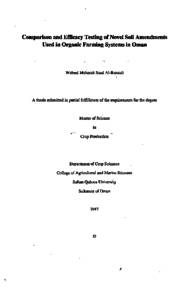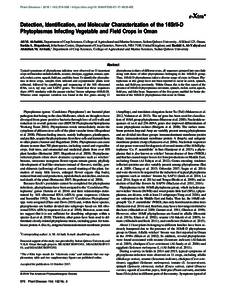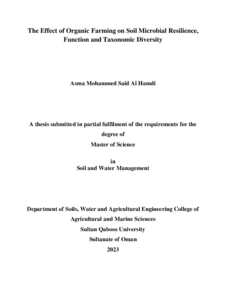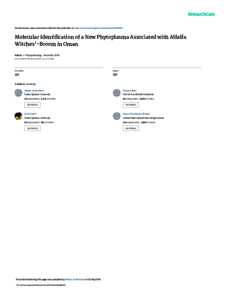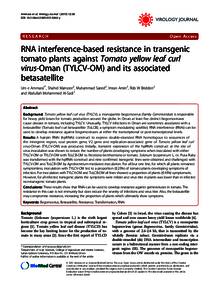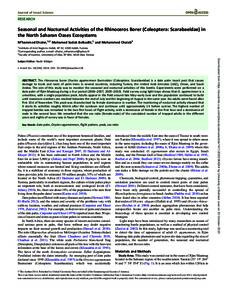Document
The Effect of organic farming practices on soil chemical, biological properties, and as a source of antagonistic bacteria against damping-off disease.
Other titles
تأثير ممارسات الزراعة العضوية على الخواص الكيميائية الأحيائية للتربة وكمصدر للبكتيريا المضادة لمرض ذبول البادرات
Publisher
Sultan Qaboos University.
Gregorian
2023
Language
English
English abstract
The study was conducted in three parts: the first part aimed to investigate the
impact of long-term farming practices on the chemical and biological properties of
soil, the second part aimed to investigate the effect of conventional and organic
greenhouse farming systems on soil chemical properties, microbial enumeration,
activity, and diversity, and the third part aimed to test the efficacy of rhizosphere
bacterial antagonists against cucumber damping-off caused by Pythium
aphanideramtum on compost amended soils under greenhouse conditions. In the first
study, the results of soil tests on samples collected from eight farms indicated
significant changes in average soil chemical and biological properties over time, such
as an increase in soil electrical conductivity from 'low salinity' to 'highly saline', a
decrease in soil pH from 8.4 to 7.5, an increase in organic matter from 'very low' to
'medium' and an increase in Olsen phosphorus from deficient to excessive. Also, an
increase in sodium, magnesium, chloride, and sulfate ions was observed while no
significant differences were observed in soil potassium and calcium concentration. In
second study, soil samples were collected from four conventional and six organic
greenhouses on farms in Oman. The results showed that on average the soil from
conventionally farmed greenhouse had significantly higher NO3-, soil respiration, and
microbial metabolic quotient than organically farmed greenhouses. On the other hand,
organic greenhouses exhibited higher soil pH and organic matter, bacterial
enumeration, and substrate-induced respiration. The results of third study revealed that
the Chryseobacterium gleum (B2) isolate was the most effective treatment among the
nine isolates tested, reducing the seedling damping-off incidence by 50% compared to
the Pythium-infected control. The C. gleum (B2) treatment also reduced the mycelium
radius and diameter growth of P. aphanidermatum by 32.8% and 34% respectively,
compared to the control. The soil amended with compost had several volatile organic
compounds compared to non-organic soil, and the Chryseobacterium gleum (B2)
bacterial isolate also released certain volatile organic compounds that showed potential
in controlling the damping-off disease. The major volatile organic compounds released
by non-organic soil were Undecane, 2,4-dimethyl- (25%), Cyclopentasiloxane,
decamethyl- (15%), Cyclotetrasiloxane, octamethyl- (13%), and Heptane, 2,4-
dimethyl-(7.85%). While those in soil amended with compost were
Cyclopentasiloxane, decamethyl- (20.58%), Cyclotetrasiloxane, octamethyl-
(18.78%), Pentane, 2-methyl- (10.21%), Acetone (8.54%), Cyclotrisiloxane,
hexamethyl- (8.2%), Cyclohexasiloxane, and dodecamethyl- (7.27%).
Chryseobacterium gleum (B2) bacterial isolate also released l-Alanine ethylamide,
(S)- (28.65%), 1-Dodecene (13.3%), Disulfide, dimethyl (9.18%), 9-Octadecenoic
acid (Z)-, methyl ester (6.04%), and Butanoic acid, and 3-methyl-, ethyl ester (5.81%).
The results of the study indicate that the C. gleum (B2) isolate shows high potential to
control damping-off disease biologically and can be used in sustainable agricultural
practices.
Member of
Resource URL
Arabic abstract
تم إجراء الدراسة في ثلاثة أجزاء: الجزء الاول هدف إلى التحقق من تأثير الممارسات الزراعية طويلة المدى على الخصائص الكيميائية والاحيائية للتربة، والجزء الثاني هدف إلى التحقيق في تأثير أنظمة الزراعة التقليدية والعضوية في البيوت ألمحمية الزراعية على الخصائص الكيميائية للتربة، وتعداد ونشاط وتنوع الكائنات الحية الدقيقة، والجزء الثالث هدف إلى اختبار فعالية مضادات البكتيريا المعزولة من تربة محسنة بالسماد العضوي ضد مرض ذبول البادرات على نبات الخيار الناجم عن المسبب aphanideramtum Pythium تحت ظروف البيوت الدفيئة. في الدراسة الاولى، أشارت نتائج اختبارات التربة على عينات تم جمعها من ثماني مزارع إلى حدوث تغيرات كبيرة في متوسط الخواص الكيميائية والاحيائية للتربة بمرور الوقت، مثل زيادة التوصيل الكهربائي للتربة من "منخفضة الملوحة" إلى "عالية الملوحة"، وانخفاض في درجة الحموضة في التربة من 8.4 إلى ،7.5 وزيادة في المواد العضوية من "منخفض جدًا" إلى "متوسط" وزيادة في عنصر الفوسفور. كما لوحظ زيادة في أيونات الصوديوم والمغنيسيوم والكلوريد والكبريتات بينما لم يالحظ وجود فروق معنوية في تركيز البوتاسيوم والكالسيوم في التربة. في الدراسة الثانية، تم جمع عينات من التربة من أربعة محميات دفيئة بنظام الزراعة التقليدية وستة محميات دفيئة بنظام الزراعة العضوية من مزارع في سلطنة عمان. أظهرت النتائج أن - تربة المحميات الدفيئة الزراعية التقليدية تحتوي في المتوسط على النترات ) 3NO) ، وتنفس التربة، وحاصل الايض الميكروبي أعلى بكثير من المحميات الدفيئة الزراعية العضوية. من ناحية أخرى، أظهرت تربة المحميات الدفيئة العضويةارتفاع درجة الحموضة والمواد العضوية، والتعداد البكتيري، والتنفس الناتج عن الركيزة )SIR). أظهرت نتائج الدراسة الثلاثة أن عزلة (2B (gleum Chryseobacterium كانت الاكثر فاعلية بين العزالت التسع المختبرة، حيث قللت من حدوث ذبول البادرات للشتالت بنسبة ٪50 مقارنة بمجموعة التحكم المصابة بالبيثيوم. كما قللت إضافة (2B (gleum .C من نصف قطر الفطريات وقطر نمو aphanidermatum .P بنسبة ٪32.8 و ٪34 على التوالي، مقارنة بمجموعة التحكم. تحتوي التربة المعدلة بالسماد على العديد من المركبات العضوية المتطايرة مقارنة بالتربة غير العضوية، كما أطلقت العزلة البكتيرية Chryseobacterium (2B (gleumبعض المركبات العضوية المتطايرة التي أظهرت إمكانات في السيطرة على مرض ذبول البادرات. كانت المركبات العضوية المتطايرة الرئيسية المنبعثة من التربة غير العضوية هي Undecane، و -2،4 ، Cyclotetrasiloxane و ،decamethyl- (15٪) و ،Cyclopentasiloxane و ،dimethyl- (25٪) و (13٪) -octamethyl، و Heptane ، 2،4 -ثنائي ميثيل- )7.85٪(. بينما تلك الموجودة في التربة المعدلة octamethyl- ،Cyclotetrasiloxane ،decamethyl- (20.58٪) ، Cyclopentasiloxaneهي بالسماد ،Cyclotrisiloxane ،Acetone (8.54٪) ،-methyl- (10.21٪)2 ،Pentane ،(18.78٪) ( (8.2٪) -hexamethyl، وسيكلوهيكساسيلوكسان، ودوديكاميثيل- )7.27٪(. أطلقت العزلة البكتيرية -Dodecene 1 ،(S) - (28.65٪) ،l-Alanine ethylamide ضاً أيChryseobacterium gleum (B2) ix methyl ester (6.04٪) ،-Octadecenoic acid (Z) - 9 ،)9.18٪( ميثيل ثنائي ،كبريتيد ثنائي ،)13.3٪ ( ، وحمض البوتانويك، و -3ميثيل، وإيثيل إستر )5.81٪(. تشير نتائج الدراسة إلى أن عزلة (2B (gleum .C تُظهر قدرة عالية على السيطرة على مرض ذبول البادرات بيولوجيًا ويمكن استخدامها في الممارسات الزراعية المستدامة.
Category
Theses and Dissertations


